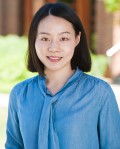2016, 2019, 2023
Jue Liang
- Assistant Professor
- Denison University

Abstract
Yeshe Tsogyel is the preeminent female saint in Tibet. Hagiographical accounts depicting her life story and literary efforts making her the exemplary female practitioner of Tibetan Buddhism began in the 12th century and culminated in a long hagiography in the 17th century. This dissertation examines some earlier strata of this hagiographical corpus that have just come to light. It makes use of both standalone hagiographies of Yeshe Tsogyel and hagiographical accounts from different literary genres. It will fill the narrative gap between her actual life and the time she was promoted as the woman saint of Tibet. This project also sheds light on how the hagiographical tradition changed course in Tibetan history by investigating the way in which she was remembered and recreated.
Abstract
Although widely recognized as the most important Tibetan Buddhist woman today, full-length literary accounts of Yeshe Tsogyel’s life story did not occur until the fourteenth and fifteenth centuries. My dissertation, titled "Conceiving the Mother of Tibet: The Life, Lives, and Afterlife of Yeshe Tsogyel," asks how her literary tradition was formed during this time in the Nyingma Treasure tradition. It considers her to be one of the central characters in the origin narrative of Treasure tradition and argues that her posthumous elevation of status resulted from the tradition’s effort to trace its religious pedigree and define its authority. Her literary representations in the narrative in turn illustrate how sainthood and femininity are conceptualized by the Treasure authors.
Abstract
In the early 1980s, at a remote Tibetan monastery called Larung Gar, nuns were granted access to advanced Buddhist learning for the first time in history. A recent development in their saga is the construction of a dedicated library for their use. This pro-woman initiative provides us with an indigenous theory of gender equality. However, with the strict censorship on any discussion of gender in China, the gender discourse and practice of these nuns are either only obliquely expressed or simply inaccessible in written words. This project seeks the “renunciant everyday” in the space of a library and queries their lived and localized expressions therein. This new framework introduces everyday complexities that cannot be neatly or safely presented in written forms, and are a preferred site of self-expression and actualization.

